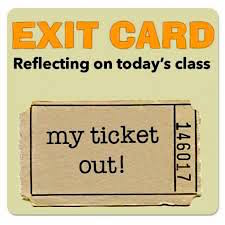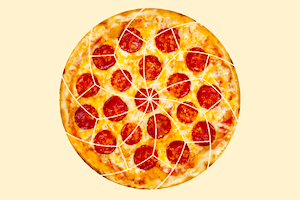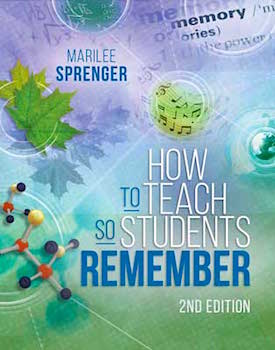7 Brain-Based Ways to Make Learning Stick
“I teach a great lesson on Monday, and by Tuesday, they’ve forgotten it. What’s wrong with their brains?”
“I can top that! I asked my social studies students to do a simple multiplication problem using fractions, and they said they had never learned fractions! I marched their math teacher into my classroom and suddenly they remembered!”
I can remember years ago handing back a chapter test to my students. The grades were disappointing. One brave young man raised his hand and said, “Mrs. Sprenger, you didn’t ask the right questions. I didn’t study this!”
Along with the teachers quoted above, I believed that this failure to learn was the students’ problem. They are so busy with their Minecraft games and Instagram accounts, they just aren’t taking the time to pay attention and practice information to get it into long-term memory.
My colleagues and I were impulsively saying, “These kids today…what are we going to do with them? Their brains just don’t hold on to information.” The funny thing is, I’d been saying that for each decade that I’d been teaching.
It was time for me to quit playing the blame game and find out what was going on inside their brains.
Understanding what makes memory sticky
When my students forget from day to day (short-term memory) and from year to year (long-term memory) can I just blame their distracted brains? Or is there a teaching issue here? The fact is, moving learning from short-term to long-term memory is not a single step.
For most information to be remembered, seven separate steps are required. Most are steps that teachers have been trained to use, but there are a few things we miss, according to the experts.

He agreed with the following steps which I have been using and sharing ever since. They are not “lock steps” – the order may change depending on the information being learned. What’s important is addressing all seven.
- Reach. In order for any information to be stored in the brain, it must be received through sensory memory. It therefore behooves us to take into consideration novelty, need, choice, attention, motivation, emotion, and meaning to get and keep student attention.
- Reflect. There’s an old joke about teaching being the instructor’s ability to take his notes and give a lecture that will go to the student’s notes without passing through either’s brain. Giving students time to “linger over learning,” may help make the connections from new material to old.
- Recode. This is simply the act of students taking information and putting it in their own words. We know that self-generated material is better remembered. Writing is a memory strategy.
- Reinforce. Once students have recoded, teachers must provide feedback on the recoded information. We don’t want to rehearse misinformation.
- Rehearse. Strategies for rehearsal will help teachers and students discover optimal rehearsal techniques.
- Review. Whereas rehearsal puts information into long-term memory, review presents the opportunity to retrieve that information and manipulate it in working memory. This act makes the memory stronger.
- Retrieve. The type of assessment used can affect the student’s ability to retrieve stored information. Accessing stored memories may be reliant on specific cues.
What I have discovered by visiting schools and observing thousands of teachers is that two of these steps – reflect and recode – are often missed. Lack of time is usually the culprit.
Yet think about how much time re-teaching takes. If we can give our students the opportunity to reflect and make connections to prior learning, the networks in their brains related to the content are “awakened” and ready to be used. And if we take the time for students to recode, we get to know if they know it.
For this short article I am going to share some of my favorite cross-content strategies for each of the steps.
Step 1: Reach
When students enter the room to study the Lewis and Clark expedition, instead of beginning with a short lecture, there’s a picture of a very large mosquito on the smartboard or screen. Beneath the picture is written: One of the biggest obstacles of the Lewis and Clark expedition is mosquitoes. There are so many that you often inhale them! Research how you might deal with this problem as a member of the expedition. Visuals get students’ attention.
Step 2: Reflect
I know my students may not think about their learning without a tool. I like to give them a question to think about, talk about, or write about. All three modes lead to reflection. Such a question might be, “What do you know about this topic that might help others understand it?”
Step 3: Recode
I was fortunate to have small white boards in my classroom with enough for each student. They recode and I walk around watching them. From a standing position, I can read what they are writing or drawing. This lets me know in just a few minutes whether they “get” it. If you don’t have white boards, slide a sheet of white paper in a page protector and use these with dry erase markers.

Step 4: Reinforce
A study by several prestigious universities recently shared the 19 word-phrase that provides the strongest effects from feedback. “I’m giving you these comments because I have very high expectations and I know that you can reach them.” Share this message with your students as you check their recoding and reinforce the learning. Even on their Exit cards, write something!
Step 5: Rehearse
I have many favorite rehearsal strategies. Once the students have the basics of what you want them to learn, it’s time to practice. At this point in the learning I focus on the five memory systems: semantic, episodic, emotional, procedural, and automatic.
Here’s an example. Studying fractions? These ideas address all five systems:
Semantic: Work problems on the board.
Episodic: Take a “field trip” around the school and find items that are fractions (half-full glass of water; a room with some stacked and some unstacked chairs; etc.)

Procedural: Bring in a bag of different colored candies. Have students sort the candy by color. Ask students to count the total number of candies and figure out what fraction of the total each color represents.
Automatic: Use flashcards for students to learn fractions and decimals. There are also fraction videos with fun songs filled with information.
Step 6: Review
Usually review revolves around the question, “Do you have any questions?” or “What would you like to review?” But kids don’t know what they don’t know. Writing down what’s in their brains, comparing with other students, and discussing differences raises test scores!
I like to have groups of students create mind maps using their notes, texts, etc. Then we hang up the maps and the students compare. They can see what they forgot, what is inaccurate, and what is unimportant. Practice tests (retrieval practice) are always a strong component of review.
Step 7: Retrieve
Practice testing, also called retrieval practice, is possibly the BEST way to know if students know. I like using Blank Page strategies as I describe in detail in my book How to Teach So Students Remember (ASCD, 2018). If you are giving a selected response test, add a blank page at the end of the test on which students can write what they know about the topic. This recognizes that sometimes we don’t ask the right questions in the right way for every student!
When we think about students learning, we usually think about how to get information into memory. But we know that we also have to get the information out. Practice these steps to strengthen their connections to the learning and make memories permanent.
Also see Marilee’s 2023 MiddleWeb article:
5 Ways to Be Sure That Lessons Stick in Memory

Marilee was a classroom teacher for 25 years, mostly at the middle school level. Her bestsellers include How to Teach So Students Remember (2nd Edition), Social Emotional Learning and the Brain; and her latest, The Missing Link to Help Them Think: Connecting Executive Function and SEL Skills to Boost Student Achievement, all from ASCD.
Marilee can be reached at her website and at brainlady@gmail.com. Find all her MiddleWeb posts here.































Thank you for a great post on different ways to help learning stick in our students! I hope that many teachers will be able to read these and implement more evidence-based teaching techniques into their classrooms. I agree with your seven methods; not only do they make a lot of sense, but they mostly have firm backing from research. In an extensive, cognitive-psychological evaluation of different learning strategies by Dunlosky et al (2013), I can find a lot of evidence for the strategies that you have listed here.
First, the two strategies of reflecting and recoding relate to transfer-appropriate processing, which is the phenomenon that simply states that people remember what they think about. Elaborative interrogation is similar to reflecting in that teachers prompt their students to generate explanations for why something is true. This would give students the time to “linger over learning” and think about what they are processing. Elaborative interrogation was shown to improve performance on associative memory tasks, although it helps more for those with higher background knowledge. Recoding can be done through the strategy of self-explanation, which is having students explain their thinking process during learning. In a study by Berry (1983), the problem-solving accuracy of students who self-explained was compared with the accuracy of students who did not self-explain. There was not too much difference between the two groups in concrete practice problems, but when they were prompted to transfer the concepts abstractly, the students who self-explained performed significantly better, which shows that recoding can benefit students, especially when they need to transfer knowledge to novel situations. However, it is key to recognize that simply summarizing as a way to recode might not be as beneficial as many teachers believe. According to Dunlosky et al (2013), summarizing was rated as low utility, for it was shown to be only effective for the students who were already proficient at summarizing. The effectiveness of summarizing mostly depends on the quality of the summary .
Practice, or rehearsal as you put it, is also extremely supported by evidence in research. However, rather than mindless repetition or less engaging practices like rereading, deliberate practice to improve the target skill shows large effects. Specifically, distributed practice, or distributed learning sessions over time, resulted in higher test scores after long time delays as compared to back-to-back practice sessions. Reinforcing, or providing feedback, is also important, as a study by David et al (2006) explained that people have limited self-assessment skills. Thus, it is important as teachers to provide immediate feedback to the students as they practice in distributed manners.
Perhaps one of the most effective learning strategies would be reviewing and retrieving practice. As you explained, these strategies give practice in manipulating the retrieved information in working memory. Practice testing resulted in better test scores when compared to simply restudying (Roediger and Karpicke 2006), and it was shown to be much more generalizable across different contexts. After a one week delay, those who did practice tests performed much better on an inference-based test than those who simply restudied, even in questions that involved far transfer questions that required concepts to be applied in novel domains (Butler 2010).
The importance of these simple strategies you listed, the seven ways of teaching to counter the “seven sins”, is highlighted by all of the research-based evidence. Yet, the sad part is that teachers are unaware of these methods and continue to regurgitate or repeat traditional ways from the same old system. The first step to change is awareness, and we must begin by educating ourselves on misconceptions and research-based strategies to realize the power of words and specific teaching methods. We must also be mindful of how such research-based strategies could differ depending on the contexts of application. Thank you so much for bringing these strategies into the light, and I hope that those of us interested in education will continue to seek connections between psychology and education to further understand the thought processes of our students on a cognitive level.
Thanks for adding such pertinent information to the article. I learned almost as much from your reply as I did from the helpful article.
Great article content and unusual terminology makes this information “sticky” for me. Thanks for your thoughtful and articulate approach.
This article is full of useful information. I found it to be extremely pertinent to my everyday teaching. I can walk into my classroom and use it tomorrow.
This artical is useful and educative.
I never knew that the three R’s of education, reading, writing and ‘rithmetic, had been increased and augmented to the seven R’s of better learning with improved retention. I think many teachers forget what it’s like to be young and basically mindless, especially boys/young men. However, there is HOPE! Boys do grow up, mature and find success in time. Your seven R’s, in part, I have implemented in variety of teaching modalities. Thank you for the ideas and suggestions you impart in the article.
A great and useful article. I really liked the examples used and how we can incorporate these ideas in our own teaching.
A very useful and meaningful article. It really remind us of how students learn and remember.
The strategies outlined in this article are incredibly valuable for both teachers and students. As an educator, I can see how implementing these techniques can significantly enhance the learning experience in my classroom.
This article is full of important tips in helping us teachers to help students be more successful.
Thank you, This is a timely reminder on a process i may have let slip.